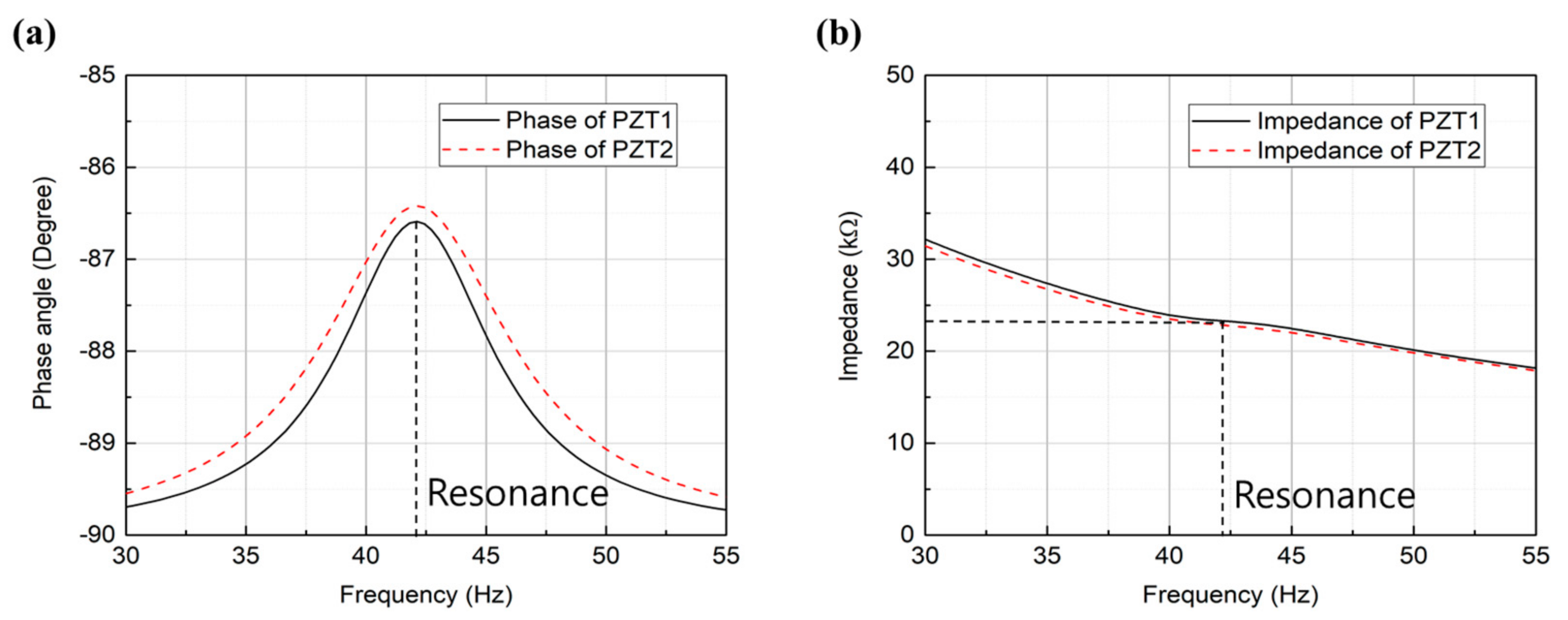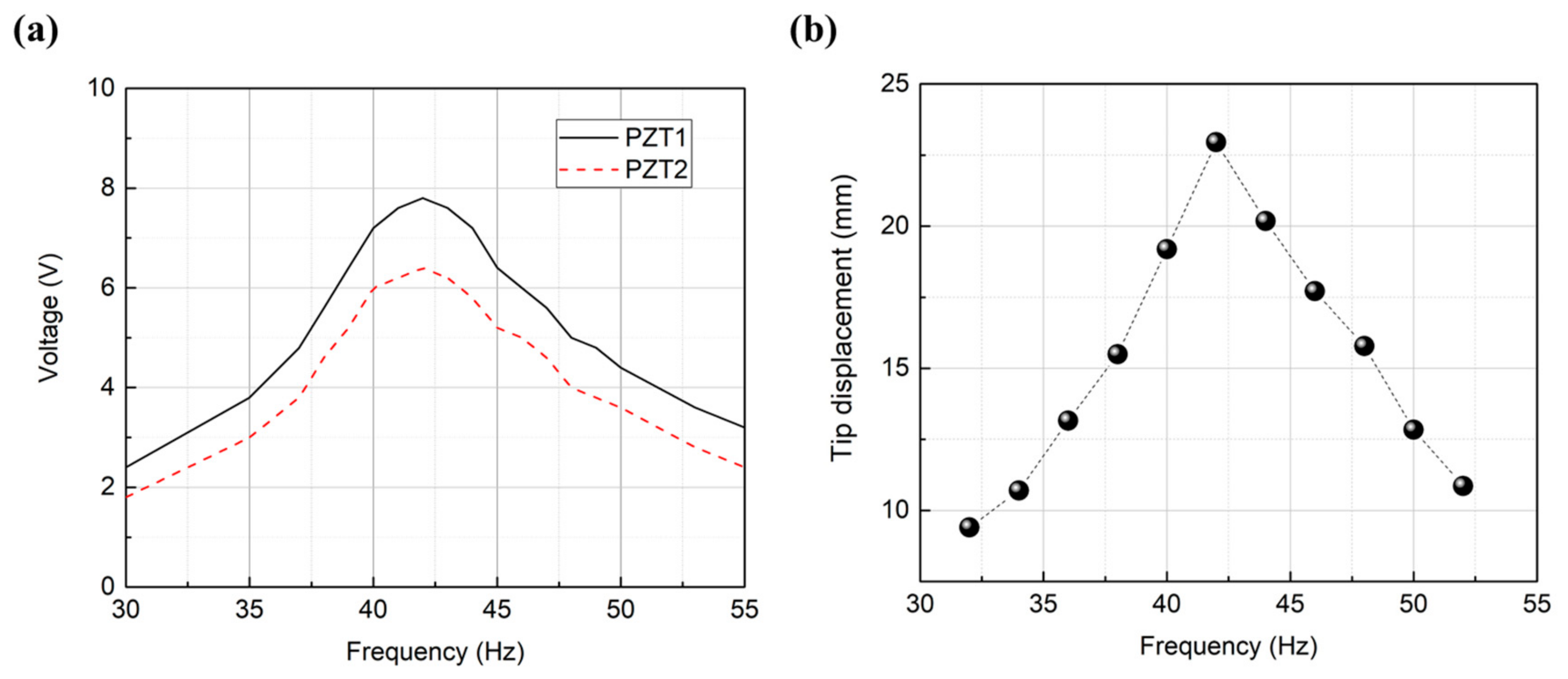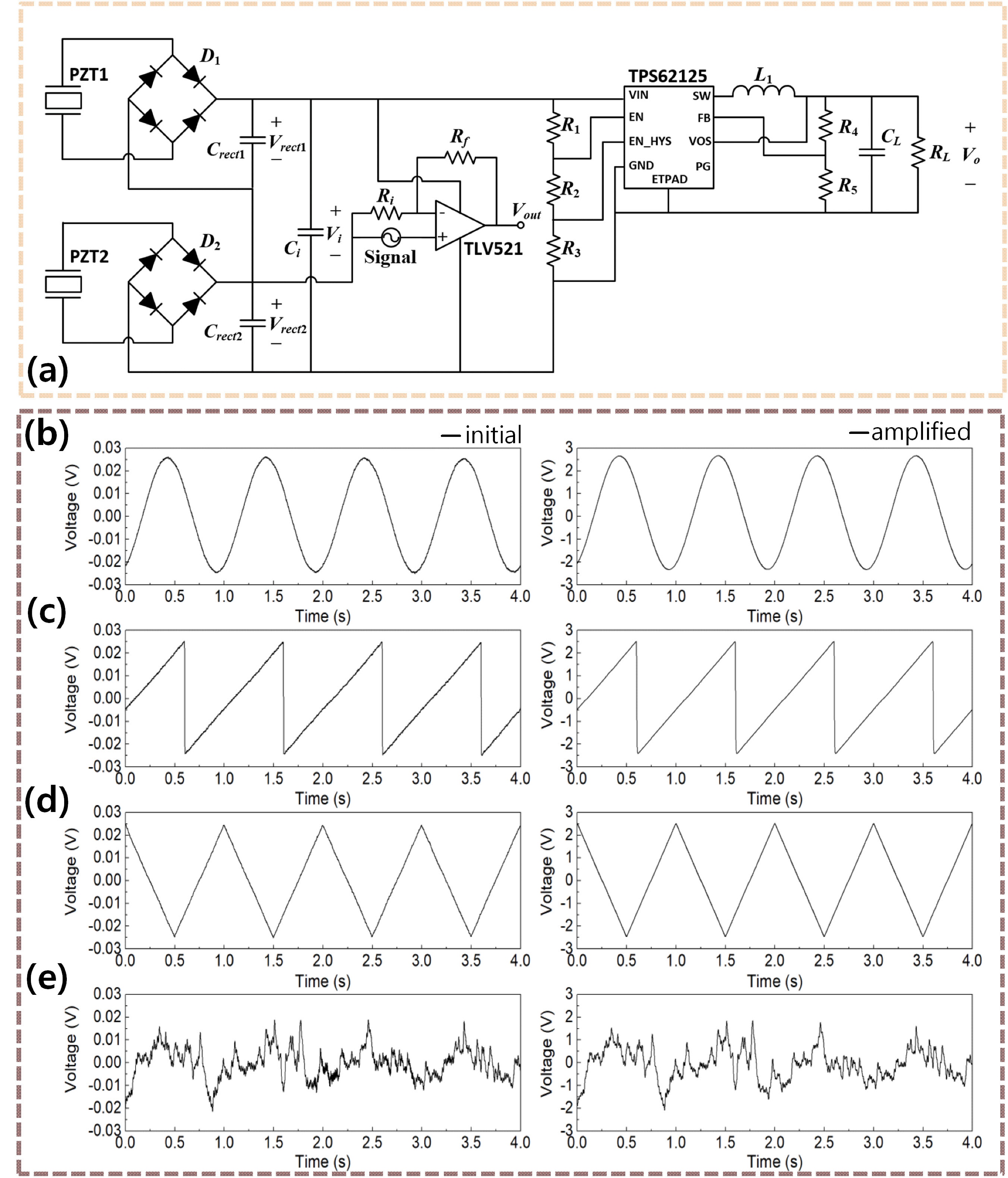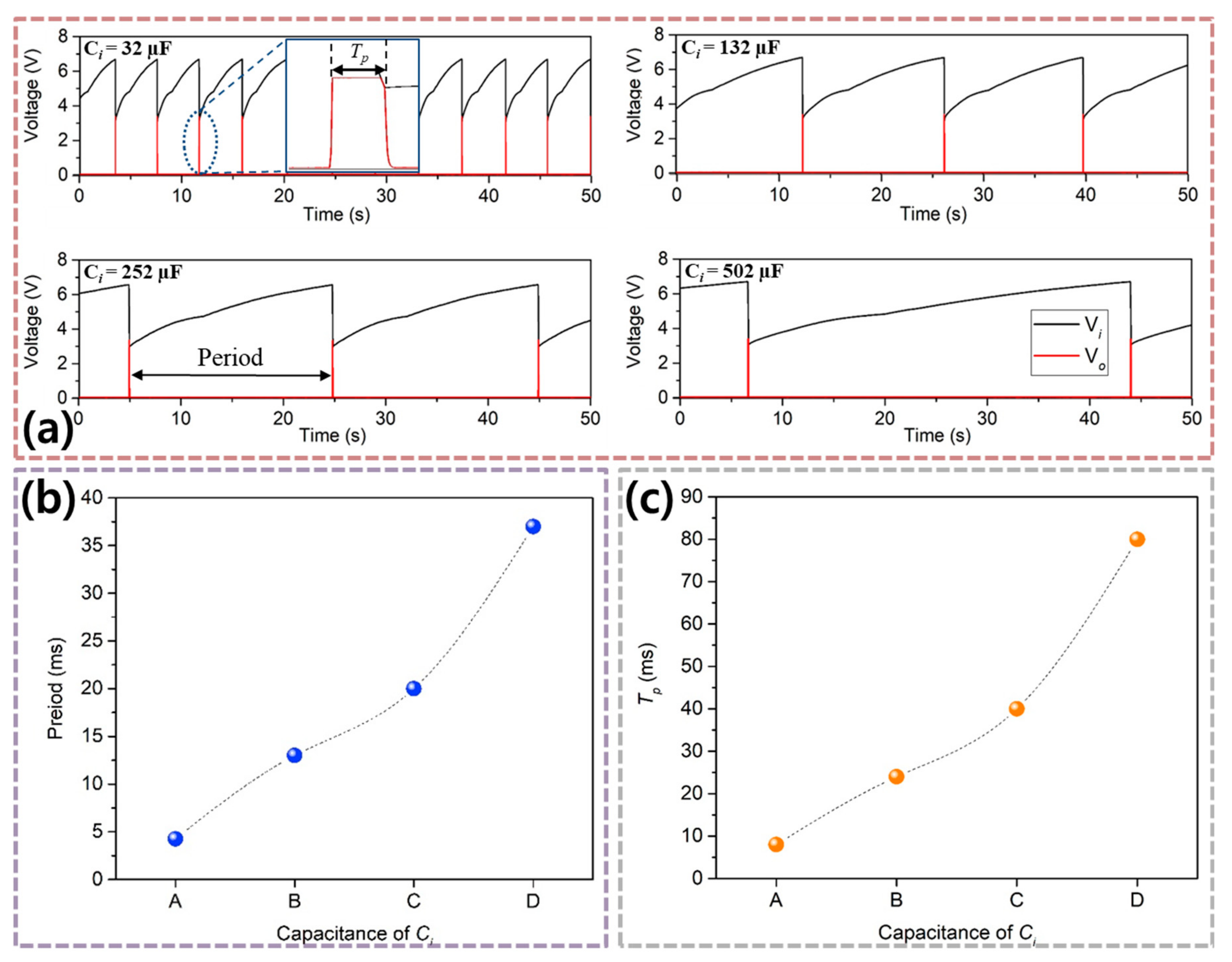Self-Powered Operational Amplifying System with a Bipolar Voltage Generator Using a Piezoelectric Energy Harvester
Abstract
1. Introduction
2. Method
2.1. Energy Harvester Design
2.2. Simulation of Piezoelectric Devices
2.3. Experimental Analysis
3. Results and Discussion
4. Conclusions
Supplementary Materials
Author Contributions
Funding
Acknowledgments
Conflicts of Interest
References
- Yang, W.; Towfighian, S. Low frequency energy harvesting with a variable potential function under random vibration. Smart Mater. Struct. 2018, 27, 114004. [Google Scholar] [CrossRef]
- Liao, Y.; Liang, J. Maximum power, optimal load, and impedance analysis of piezoelectric vibration energy harvesters. Smart Mater. Struct. 2018, 27, 075053. [Google Scholar] [CrossRef]
- Woo, M.S.; Hong, S.K.; Jung, H.J.; Yang, C.H.; Song, D.; Sung, T.H. Study on the Strain Effect of a Piezoelectric Energy Harvesting Module. Ferroelectrics 2013, 449, 33–41. [Google Scholar] [CrossRef]
- Seung, W.; Gupta, M.K.; Lee, K.Y.; Shin, K.S.; Lee, J.H.; Kim, T.Y.; Kim, S.; Lin, J.; Kim, J.H.; Kim, S.W. Nanopatterned textile-based wearable triboelectric nanogenerator. ACS Nano 2015, 9, 3501–3509. [Google Scholar] [CrossRef] [PubMed]
- Yi, F.; Lin, L.; Niu, S.; Yang, P.K.; Wang, Z.; Chen, J.; Zhou, Y.; Zi, Y.; Wang, J.; Liao, Q.; et al. Stretchable-rubber-based triboelectric nanogenerator and its application as self-powered body motion sensors. Adv. Funct. Mater. 2015, 25, 3688–3696. [Google Scholar] [CrossRef]
- Brogan, Q.; O’Connor, T.; Ha, D.S. Solar and thermal energy harvesting with a wearable jacket. In Proceedings of the 2014 IEEE International Symposium on Circuits and Systems (ISCAS), Melbourne, Australia, 1–5 June 2014; pp. 1412–1415. [Google Scholar]
- Wang, C.; Li, J.; Yang, Y.; Ye, F. Combining Solar Energy Harvesting with Wireless Charging for Hybrid Wireless Sensor Networks. IEEE Trans. Mob. Comput. 2018, 17, 560–576. [Google Scholar] [CrossRef]
- Jeong, S.Y.; Hwang, W.S.; Cho, J.Y.; Jeong, J.C.; Ahn, J.H.; Kim, K.B.; Do Hong, S.; Song, G.J.; Jeon, D.H.; Sung, T.H. Piezoelectric device operating as sensor and harvester to drive switching circuit in LED shoes. Energy 2019, 177, 87–93. [Google Scholar] [CrossRef]
- Zhang, H.; Corr, L.R.; Ma, T. Effects of electrical loads containing non-resistive components on piezoelectric energy harvesting. Mech. Syst. Signal Process. 2018, 111, 210–221. [Google Scholar] [CrossRef]
- Ko, E.J.; Jeon, S.J.; Han, Y.W.; Jeong, S.Y.; Kang, C.Y.; Sung, T.H.; Seong, K.W.; Moon, D.K. Synthesis and characterization of nanofiber-type hydrophobic organic materials as electrodes for improved performance of PVDF-based piezoelectric nanogenerators. Nano Energy 2019, 58, 11–22. [Google Scholar] [CrossRef]
- Kim, M.O.; Pyo, S.; Oh, Y.; Kang, Y.; Cho, K.H.; Choi, J.; Kim, J. Flexible and multi-directional piezoelectric energy harvester for self-powered human motion sensor. Smart Mater. Struct. 2018, 27, 035001. [Google Scholar] [CrossRef]
- Jeong, S.Y.; Jung, H.J.; Jabbar, H.; Hong, S.K.; Ahn, J.H.; Sung, T.H. Design of a multi-array piezoelectric energy harvester for a wireless switch. Int. J. Hydrogen Energy 2016, 41, 12696–12703. [Google Scholar] [CrossRef]
- Cho, J.Y.; Choi, J.Y.; Jeong, S.W.; Ahn, J.H.; Hwang, W.S.; Yoo, H.H.; Sung, T.H. Design of hydro electromagnetic and piezoelectric energy harvesters for a smart water meter system. Sens. Actuators A Phys. 2017, 261, 261–267. [Google Scholar] [CrossRef]
- Jung, H.J.; Song, Y.; Hong, S.K.; Yang, C.H.; Hwang, S.J.; Jeong, S.Y.; Sung, T.H. Design and optimization of piezoelectric impact-based micro wind energy harvester for wireless sensor network. Sens. Actuators A Phys. 2015, 222, 314–321. [Google Scholar] [CrossRef]
- Jabbar, H.; Do Hong, S.; Hong, S.K.; Yang, C.H.; Jeong, S.Y.; Sung, T.H. Sustainable micro-power circuit for piezoelectric energy harvesting tile. Integr. Ferroelectr. 2017, 183, 193–209. [Google Scholar] [CrossRef]
- Chang, S.K.; Chen, K.W.; Yang, S.D.; Yang, C.L.; Cheng, K.W. An Autonomous Wireless Transmitter with Piezoelectric Energy Harvester from Short-Duration Vibrations. In Proceedings of the 2018 IEEE International Symposium on Circuits and Systems, Florence, Italy, 27–30 May 2018; pp. 1–4. [Google Scholar]
- Lee, M.; Yang, J.; Park, M.J.; Jung, S.Y.; Kim, J. Design and Analysis of Energy-Efficient Single-Pulse Piezoelectric Energy Harvester and Power Management IC for Battery-Free Wireless Remote Switch Applications. IEEE Trans. Circuits Syst. I Regul. Pap. 2018, 65, 366–379. [Google Scholar] [CrossRef]
- Kumar, A.; Kiran, R.; Kumar, S.; Chauhan, V.S.; Kumar, R.; Vaish, R. A Comparative Numerical Study on Piezoelectric Energy Harvester for Self-Powered Pacemaker Application. Glob. Chall. 2018, 2, 1700084. [Google Scholar] [CrossRef]
- Bouzelata, Y.; Kurt, E.; Uzun, Y.; Chenni, R. Mitigation of high harmonicity and design of a battery charger for a new piezoelectric wind energy harvester. Sens. Actuators A Phys. 2018, 273, 72–83. [Google Scholar] [CrossRef]
- Zhao, S.; Erturk, A. Deterministic and band-limited stochastic energy harvesting from uniaxial excitation of a multilayer piezoelectric stack. Sens. Actuators A Phys. 2014, 214, 58–65. [Google Scholar] [CrossRef]
- Hwang, S.J.; Jung, H.J.; Kim, J.H.; Ahn, J.H.; Song, D.; Song, Y.; Lee, H.L.; Moon, S.P.; Park, H.; Sung, T.H. Designing and manufacturing a piezoelectric tile for harvesting energy from footsteps. Curr. Appl. Phys. 2015, 15, 669–674. [Google Scholar] [CrossRef]
- Gatto, A.; Frontoni, E. Energy Harvesting system for smart shoes. In Proceedings of the 2014 IEEE/ASME 10th International Conference on Mechatronic and Embedded Systems and Applications, Senigallia, Italy, 10–12 September 2014; pp. 1–6. [Google Scholar]
- Yang, C.H.; Song, Y.; Woo, M.S.; Eom, J.H.; Song, G.J.; Kim, J.H.; Kim, J.; Lee, T.H.; Choi, J.Y.; Sung, T.H. Feasibility study of impact-based piezoelectric road energy harvester for wireless sensor networks in smart highways. Sens. Actuators A Phys. 2017, 261, 317–324. [Google Scholar] [CrossRef]
- Guan, M.; Liao, W.H. Studies on the circuit models of piezoelectric ceramics. In Proceedings of the International Conference on Information Acquisition, Hefei, China, 21–25 June 2004; pp. 26–31. [Google Scholar]
- Rakotondrabe, M.; Ivan, I.A.; Khadraoui, S.; Clevy, C.; Lutz, P.; Chaillet, N. Dynamic displacement self-sensing and robust control of cantilever piezoelectric actuators dedicated for microassembly. In Proceedings of the 2010 IEEE/ASME International Conference on Advanced Intelligent Mechatronics, Montreal, ON, Canada, 6–9 July 2010; pp. 557–562. [Google Scholar]
- Palosaari, J.; Leinonen, M.; Juuti, J.; Jantunen, H. The effects of substrate layer thickness on piezoelectric vibration energy harvesting with a bimorph type cantilever. Mech. Syst. Signal Process. 2018, 106, 114–118. [Google Scholar] [CrossRef]
- Fan, X.; Li, J.; Hao, H. Impedance resonant frequency sensitivity based structural damage identification with sparse regularization: Experimental studies. Smart Mater. Struct. 2019, 28, 015003. [Google Scholar] [CrossRef]
- Ahn, J.H.; Woo, M.S.; Song, D.; Hong, S.K.; Baek, K.H.; Hwang, S.J.; Sung, T.H. Establishment of the evaluation standard and the analysis technique for the tip mass method in piezoelectric energy-harvesting systems. J. Korean Phys. Soc. 2014, 65, 1943–1950. [Google Scholar] [CrossRef]








| Material | Parameter | Value |
|---|---|---|
| Piezoelectric ceramic | Density (g/cm3) | 7.6 |
| eT33/e0 | 2300.0 | |
| d31 (10−12 mV) | 156.0 | |
| g31 (10−3 V·m/N) | 12.0 | |
| Kp (%) | 62.4 | |
| S11E (×10−12 m2/N) | 13.8 | |
| S11E (×10−12 m2/N) | 11.8 | |
| Steel substrate | Young’s modulus (GPa) | 193.0 |
| Density (g/cm3) | 8.0 |
| L1 | C1 | R1 | C0 | |
| PZT1 | 8.1 KH | 1.76 nF | 392.5 KΩ | 161.5 nF |
| PZT2 | 6.0 KH | 2.29 nF | 366.6 KΩ | 164.5 nF |
| Parameter | Value | Parameter | Value |
|---|---|---|---|
| Crect1 | 47 µF | Crect2 | 47 µF |
| Ri | 10 KΩ | Rf | 10 MΩ |
| R1 | 2.5 MΩ | R2 | 442 KΩ |
| R3 | 808 KΩ | R4 | 1.8 MΩ |
| R5 | 576 KΩ | RL | 100 Ω |
| L1 | 15 µH | CL | 10 µF |
| A | B | C | D |
|---|---|---|---|
| 32 µF | 132 µF | 252 µF | 502 µF |
© 2019 by the authors. Licensee MDPI, Basel, Switzerland. This article is an open access article distributed under the terms and conditions of the Creative Commons Attribution (CC BY) license (http://creativecommons.org/licenses/by/4.0/).
Share and Cite
Jeong, S.Y.; Cho, J.Y.; Hong, S.D.; Hwang, W.; Jabbar, H.; Ahn, J.H.; Jhun, J.P.; Sung, T.H. Self-Powered Operational Amplifying System with a Bipolar Voltage Generator Using a Piezoelectric Energy Harvester. Electronics 2020, 9, 41. https://doi.org/10.3390/electronics9010041
Jeong SY, Cho JY, Hong SD, Hwang W, Jabbar H, Ahn JH, Jhun JP, Sung TH. Self-Powered Operational Amplifying System with a Bipolar Voltage Generator Using a Piezoelectric Energy Harvester. Electronics. 2020; 9(1):41. https://doi.org/10.3390/electronics9010041
Chicago/Turabian StyleJeong, Se Yeong, Jae Yong Cho, Seong Do Hong, Wonseop Hwang, Hamid Jabbar, Jung Hwan Ahn, Jeong Pil Jhun, and Tae Hyun Sung. 2020. "Self-Powered Operational Amplifying System with a Bipolar Voltage Generator Using a Piezoelectric Energy Harvester" Electronics 9, no. 1: 41. https://doi.org/10.3390/electronics9010041
APA StyleJeong, S. Y., Cho, J. Y., Hong, S. D., Hwang, W., Jabbar, H., Ahn, J. H., Jhun, J. P., & Sung, T. H. (2020). Self-Powered Operational Amplifying System with a Bipolar Voltage Generator Using a Piezoelectric Energy Harvester. Electronics, 9(1), 41. https://doi.org/10.3390/electronics9010041





